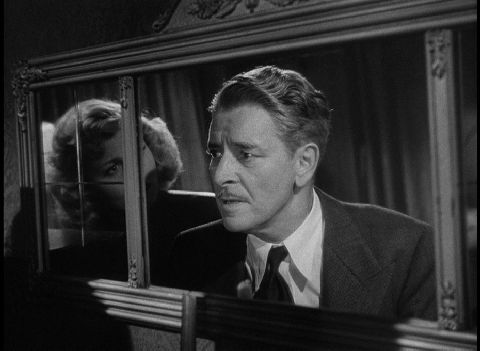A Double Life (1947) 

Director: George Cukor
Cast: Ronald Colman, Edmond O’Brien, Signe Hasso
Synopsis: Highly regarded theatre actor Anthony John’s violent temper leads his actress wife, Brita, to leave him. When the two perform together in a production of “Othello,” the strain of playing Othello drives John insane…
WARNING: This review contains SPOILERS
Those precious actors who insist on working as a refuse collector or shelf-stacker for a couple of weeks in order to ‘become’ the character they play in their latest role might do well to take note of the possible consequences depicted in George Cukor’s atmospheric A Double Life. Getting wrapped up in your work is one thing, but allowing it to take over your life can bring nothing but pain and murder. At least Tony John, Ronald Colman‘s tortured thespian, here occupies to one degree or another the role of Othello for the duration of more than 300 performances (which is incidentally, entirely unbelievable for a Shakespearean play on Broadway), instead of taking lunch breaks in his air-conditioned trailer or relaxing after a shift at the supermarket by snorting cocaine off a starlet‘s belly by the pool…
When we first meet actor Tony John (Ronald Colman) – note how our protagonist has two first names, a sly indication of his dual personality – he’s an affable enough chap, on good terms with all he meets thanks to the fact that he’s playing an equally amiable character in his latest stage hit, A Gentleman’s Gentleman. However, when the show’s run comes to an end, he’s offered the opportunity to play Othello. Knowing his own tendency to psychologically immerse himself in the roles he plays, John hesitates to take on the part of the murderous General before finally deciding to do so anyway. Of course, as soon as John has donned the garb and blacked his face his personality immediately undergoes a turn for the worse, and he becomes so consumed by the character he’s playing that, on one occasion, he has to stop himself from actually murdering his co-star – former wife Brita (Signe Hasso) – during a performance. At this point, those less dedicated to their art might have decided that it was time for a spell in Charlie’s Aunt or something equally harmless, but John perseveres and his psychosis grows worse, until he finds himself kissing to death the sluttish waitress (Shelley Winters) he has recently befriended.
Colman won the Best Actor Oscar for his performance in A Double Life, and director Cukor and co-writers Ruth Gordon and Garson Kanin were also nominated in their respective professions, so there’s no doubting the pedigree of the material, even though Colman’s performance is sometimes a trifle hammy. The screenplay is lucid and intelligent, with the story of Othello serving not only as the source of John’s increasing madness, but also as a reference point for the movie’s own plot, so that events that take place on stage eventually become mirrored by events in the ’real’ world.
John’s incipient madness is hinted at from the very first scene, not only through the structure of his name, but in the way that he is initially surrounded by images of himself – posters and busts, etc – and the way that those around him have conflicting views of the sort of person he is. It’s no wonder that the psychologically frail actor has only a tenuous grasp of his own sense of identity. The look of the film also contributes towards our impression of the state of John’s mind. Although A Double Life isn’t a typical Noir movie, it does contain all the visual elements associated with the genre: the deep shadows and dark, cluttered spaces create a sense of claustrophobia that illustrate the actor’s worsening mental state. The use of sound is also important, and put to incredibly good effect: whether it’s the way the hubbub of a party John is attending is momentarily silenced when he places his hands over his ears, the continuous blare of a car horn through a window, or the ghostly echoes of Desdemona’s lines repeated in his mind, each carefully chosen sound serves as one further milestone on John’s journey towards insanity.
As you’d expect, the urbane Ronald Colman (chosen for the role after Laurence Olivier passed) delivers a sympathetic, cultured performance – apart from when he’s rolling his eyes during one of his ‘episodes’ or rambling on interminably during a protracted death scene – but the quality of his support perhaps doesn’t quite measure up to the demands the material makes of them. Edmond O’Brien, as the friend who begins to suspect John’s affliction has started to manifest itself in murderous ways, was a serviceable enough studio actor, but he was strictly a journeyman and always looks like he belongs in a different picture. And the performance of Signe Hasso as the former wife with whom John is still friendly is so variable – ranging from excruciating to adequate – that it’s tempting to believe she was suffering from her own form of schizophrenia. Thankfully, the strength of the screenplay overcomes their shortcomings, and the lasting impression is one of an intelligent, meticulously scripted drama that deserved the accolades it received in 1948.
(Reviewed 7th June 2012)
httpv://www.youtube.com/watch?v=Yk0QGgHnMlQ
